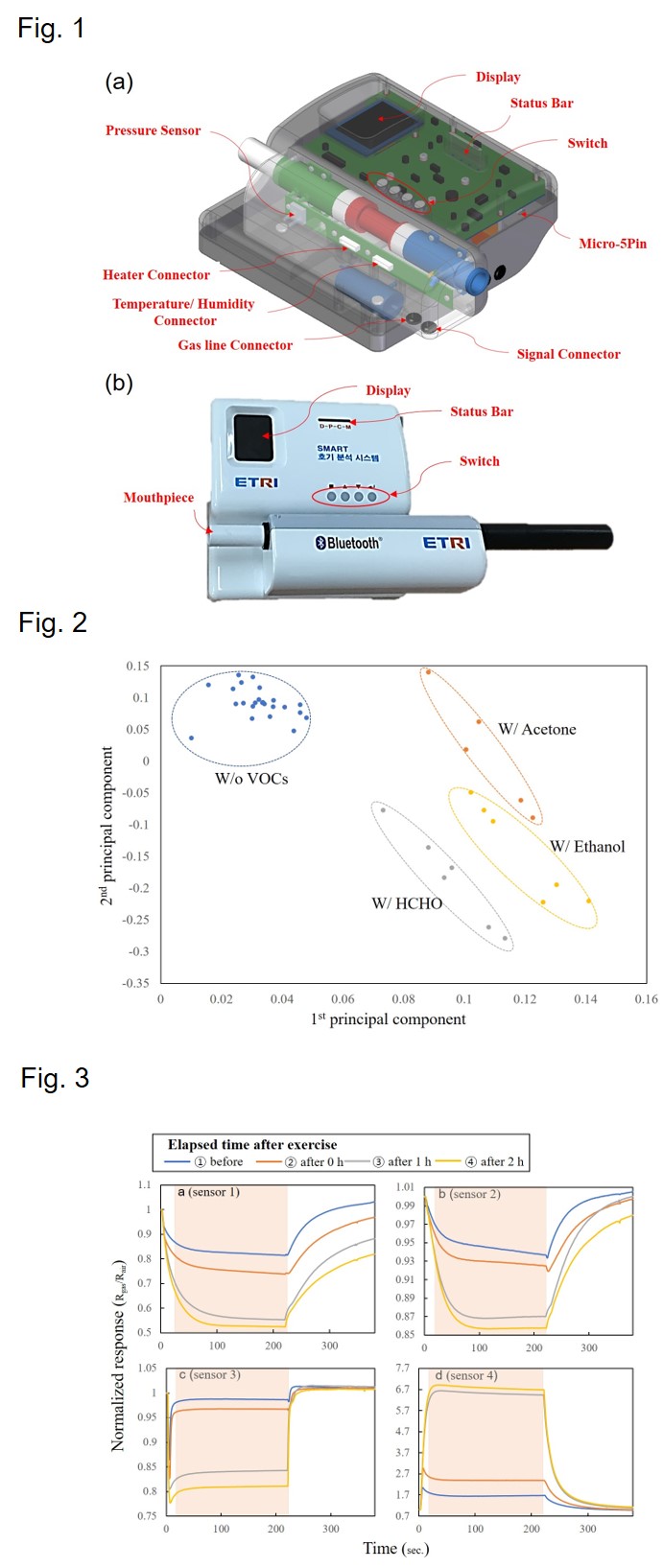Abstract
Introduction
The development of portable breath acetone analyzer has become an emerging research field in human healthcare and medical instrumentation, because the breath acetone is an important gaseous biomarker for monitoring fat burning [1, 2]. The exhaled acetone increase is a substantial indicator of the total ketone bodies produced by the liver in case of fasting, diets, exercise, and diabetes mellitus [3, 4].
The general gas analyzers based on spectrometry measurements are proven to be highly sensitive and accurate [5, 6]. But they currently have some drawbacks like complexity, expense, and bulky size, and require more studies. In this study, we fabricated a novel portable breath acetone analyzer based on the MEMS metal oxide gas sensor arrays. And the developed portable breath acetone analyzer using the sensor arrays offered simple but powerful classification ability for a group of polar volatile organic compounds (VOCs), such as ethanol, formaldehyde, and acetone respectively, by using a principal component analysis (PCA) and good responses to the exhaled breath.
Method
Figure 1 shows the schematic design and photograph of a fabricated breath acetone analyzer. It comprised breath sampler and gas detection module. The breath sampler that consisted of orifice plate, heater, CO2 sensor and pressure sensor was designed to collect the end-tidal breath. The gas detection chamber that consisted of humidity sensor, temperature sensor and four-kinds of MEMS gas sensors was designed to measure accurately the acetone concentration. And the gas flow line was controlled to minimize the influence of the external environment by one micro vacuum pump and three solenoid valves. The analyzer was mm in size and 1.3 kg in weight.
To confirm the sensing-characteristics of the fabricated breath acetone analyzer, first we did measure the responses of MEMS gas sensor array to the simply simulated breath gas, containing 2% CO2, 45% humidity and air, and those with three different 2 ppm VOCs of ethanol, formaldehyde, and acetone respectively. We confirmed the linear response to the concentration ranges of 0~ 1 ppm and investigated the classification properties of the analyzer using the PCA. We measured the exhaled-breath changes of a volunteer who was ordered to do the running exercise. The volunteer did a programmed running exercise for activating the body fat burning process. The program consists of a 20 minutes-long exercise including two running steps with a speed of 8 km/h for 5 minutes and a speed of 9 km/h for 10 minutes. 4-times breath measurements were performed using the analyzer: just before the exercise, right after the running, and thereafter 1 hour, and 2 hours during the post-running rest.
Results and Conclusions
Figure 2 shows classification results for test VOCs using PCA analysis, and the confirmed the classification possibility for each tested VOCs. We confirmed the acetone increase as time pass after exercise with GC-MS analysis and applied the analyzer to the human exhaled breath to monitor fat loss in exercise. Figure 3 shows the exhaled human breath measurement results of volunteers using the breath acetone analyzer according to the passage of the time. The measurement time (the red-colored region of graphs) and the washing time of the fabricated breath analyzer were set to 200 seconds and 150 seconds, respectively. The response values of the sensors changed linearly as a function of time passed after the exercise. The normalized responses of the p-type gas sensor (Fig.3 a, b, and c) decrease, while that of the n-type sensor (Fig.3 d) increased as time passes after exercise. It indicates that the breath acetone concentration of the volunteer increase with exercise which enhances the body fat metabolism. We are carrying out clinical tests of the analyzer with a permission of IRB in Seoul National University Hospital at Bundang and the details will discuss in the conference.
References
[1] T. Toyooka, S. Hiyama, Y. Yamada, A Prototype Portable Breath Acetone Analyzer for Monitoring Fat Loss, Journal of Breath Research. 7 (2013) 036005.
[2] M. Righettoni, A. Tricoli, Toward Portable Breath Acetone Analysis for Diabetes Detection, Journal of Breath Research. 5 (2011) 037109.
[3] J. C. Anderson, Measuring Breath Acetone for Monitoring Fat Loss, Obesity. 23 (2015) 2327-2334.
[4] S. K. Kundu, J. A. Bruzek, R. Nair, A. M. Judilla, Breath Acetone Analyzer: Diagnostic Tool to Monitor Dietary Fat Loss, Clinical Chemistry. 39 (1993) 87-92.
[5] T. P. J. Blaikie, J. Couper, G. Hancock, P. L. Hurst, R. Peverall, G. Richmond, G. A. D. Ritchie, D. Taylor, K. Valentine, Portable Device for Measuring Breath Acetone Based on Sample Preconcentration and Cavity Enhanced Spectroscopy, Analytical Chemistry. 88 (2016) 11016-11021.
[6] V. Saasa, T. Malwela, M. Beukes, M. Mokgotho, C. Liu, B. Mwakikunga, Sensing Technologies for Detection of Acetone in Human Breath for Diabetes Diagnosis and Monitoring, Diagnostics. 8 (2018)
Fig 1. Schematic design (a) and photograph (b) of a novel portable breath acetone anlayzer
Fig 2. PCA analysis using sensing data of sensor array to the simply simulated human breath with three different VOCs, actone, ethanol, and formaldehyde, and without the tested VOCs
Fig. 3 Exhaled-breath measurement results of a volunteer using the analyzer as a function of passage time after exercise

Figure 1
